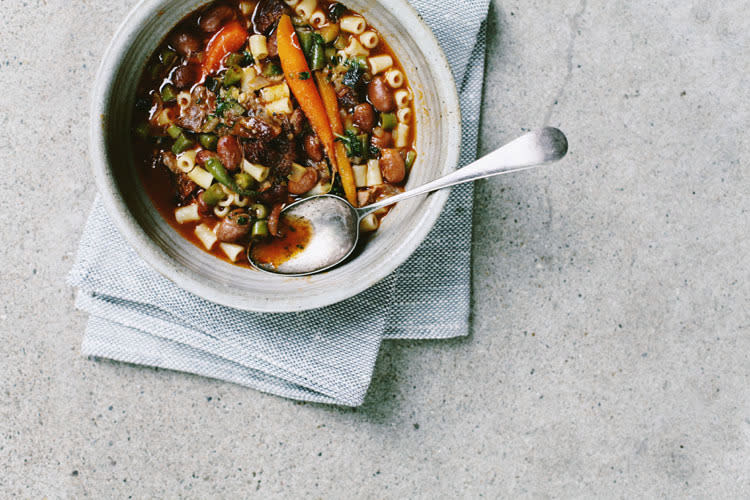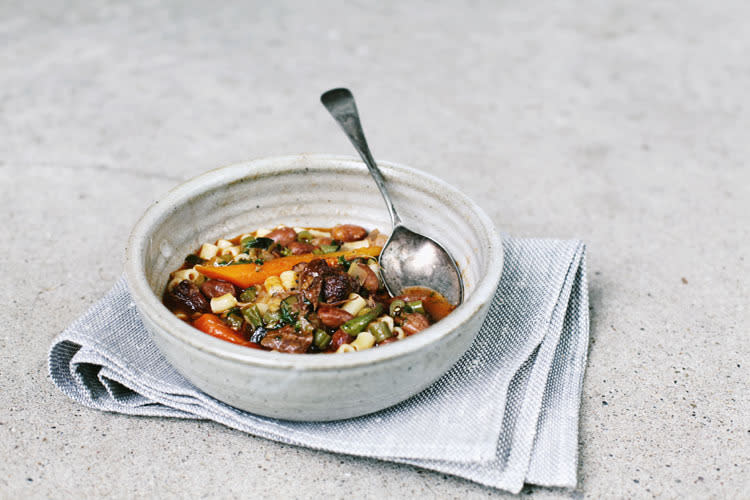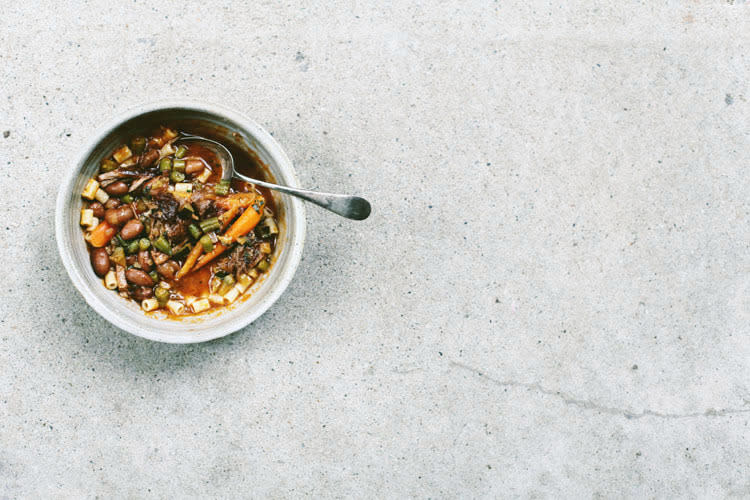Revved-Up Minestrone Soup That’s Anything But Boring
Every week, we spotlight a different food blogger who’s shaking up the blogosphere with tempting recipes and knockout photography. Here, Tara O’Brady of Seven Spoons recreates her mother’s minestrone soup, the standard against which all other minestrones are judged.

All photos courtesy of Tara O’Brady
By Tara O’Brady of Seven Spoons
I should say, traditional or not, Mum’s minestrone is the version against which I judge all minestrones. Hers has a tomato base, and a bit of beef, then it’s bulky with vegetables. When I was growing up, she’d use what was around, maybe corn and peas, always beans and carrots, and different shapes of pasta. What tied it together was oregano. The combination of oregano and tomato, the sweetness of the vegetables and the underlying savoriness of the beef, made it one of my favorite suppers. I’d blanket my bowl with a heap of grated Parmesan and enough black pepper to make me sneeze, and go to town. I still love how the cheese slumps into the soup, both creamy and salty, turning into chewy strands.
The butcher had short ribs on Saturday. Those became the foundation of my minestrone. Braised simply in a tomato and vegetable broth, the meat goes tender, the fat melting into the cooking liquid. The ribs were left overnight, then turned to soup the next afternoon. A quick base of onions, celery and zucchini was cooked with olive oil, dried oregano, and garlic, then in went the braising liquid, broth, and carrots. The vegetables were given time, cooked to the point they lost some color but gained all the richness of the broth; the squash especially, as I wanted nothing of the woolliness often found and its center. The short ribs followed into that mix, accompanied by two types of beans. After another simmer, everything was done, meeting up with bowls of pasta and greens at the table, vinegar for dripping, deeply green splotches of oregano oil, and the aforementioned cheese.
Related: Ribollita from ‘Everyone Is Italian on Sunday’

Think of that oregano oil as a rough-and-ready cheat’s take on an Italian salsa verde. It takes seconds to make, yet the almost aggressive hit of fresh herbs, garlic and chili is what lends moxie to the mellowed, stewy goodness of the soup. It is enthusiastically edgy. And on the topic of the pasta, I like a short, fat variety, think tubetti or macaroni, a kind that has a comforting chew, a sense of substance against the yield of the meat, beans and vegetables.
I like this soup for many reasons, for how it feeds a crowd, and for how it can be stretched even further to feed more; for its changeability and adaptability dependent upon season and circumstance; how it can use up leftovers, or made from scratch without fuss. I like that it is a soup I’ve known for as long as I can remember, for as long as we’ve had our kitchen table, and for the fact I get to introduce it to you.
Related: Lowcountry Okra and Tomato Soup from ‘Southern Soups & Stews’

While there’s quite a list of ingredients here, and the preparation starts the day ahead, the active time is modest and the effort is blessedly easy on the cook. It’s a case of a lot of things stirred into a pot, twice over. Neither the braising ribs or the simmering soup require babysitting, which is to say, for its length, this recipe suits a lazy mood surprisingly well.It is hard to pin down an exact measurement on the vegetable stock, but if you have 1 ½ quarts to use between the ribs and the soup, that should be enough.
Keeping both the pasta and greens separate from the minestrone means that with leftovers the noodles won’t get mushy and the greens won’t overpower or discolor the broth. Speaking of which, I use vegetable broth instead of beef because Mum’s minestrone was very much a vegetable soup with beef, rather than the other way around.
Short Rib Minestrone
Serves 6 to 8
For the short ribs:
2 ½ pounds bone-in short ribs
Salt and freshly ground black pepper
1 tablespoon olive oil
1 red onion, peeled and quartered through the root end
1 carrot, cut into chunks
1 celery stalk, cut into chunks
3 garlic cloves, bruised but left whole
1 tablespoon tomato paste
2 tablespoons red wine vinegar or a slosh of red wine
1 (28-ounce) can whole tomatoes
Vegetable broth or water, as needed
1 bay leaf, fresh or dried
For the soup:
2 tablespoons olive oil
1 red onion, medium dice
1 celery stalk, small dice
2 small zucchini, medium dice
Salt and freshly-ground black pepper
1 teaspoon dried oregano
2 garlic cloves, minced
Vegetable broth or water, as needed
2 carrots, medium dice, or left larger if skinny
2 cups cooked borlotti or cannellini beans
Approximately 6 ounces, a few handfuls, yellow wax or green beans, finely sliced
To finish:
4 ounces tubetti, cooked al dente (check package instruction), then tossed with a glug of olive oil while hot
Baby spinach, Tuscan kale or Swiss chard leaves, in shreds
Parmesan cheese
Red wine vinegar
Oregano oil (see note)
The day before serving, season the short ribs generously with salt and pepper. Cover and refrigerate for 2 hours, then remove ribs from the fridge and bring to room temperature. Preheat an oven to 350°F/175°C.
Heat the olive oil in a 5-quart Dutch oven over medium-high heat. Brown the short ribs well on all sides. Transfer to a rimmed plate, then pour off all but 2 tablespoons fat from the pot. Reduce the heat to medium.
Add the onion, carrot, celery, and garlic to the pot, and cook, stirring often, until properly golden and starting to catch in places, around 6 to 8 minutes. Clear the vegetables to the sides of the pot. Add the tomato paste and cook, stirring constantly, until the paste is caramelized, maybe 2 minutes. Stir vegetables into paste and cook for 1 minute more. Splash in the vinegar to deglaze, scraping and stirring up any sticky bits. Add the short ribs back to the pot, along with any accumulated juices, then the tomatoes and their liquid. Tamp down the tomatoes, giving them a bit of a prod and squish. Pour in enough vegetable broth or water so that the ribs are halfway submerged. Tuck in the bay leaf. Bring the pot to the boil, cover, and pop into the oven.
Cook until the ribs are tender, approximately 2 ½ hours. Skim the liquid of any impurities, then move ribs to a large bowl. Strain liquid over the meat through a fine-meshed sieve, pushing the vegetables through. Let cool completely to room temperature. Cover and refrigerate overnight.
About 2 hours before you want to eat, spoon any fat from the surface of the short ribs and cooking liquid. Leave the the pot at room temperature to lose its chill, say around an hour, then remove the short ribs on a rimmed plate. Set aside the liquid.
To make the soup, heat olive oil in a large, heavy-bottomed pot over medium heat. Add the onions, celery, and zucchini. Season with salt, pepper and oregano, then cook, stirring often, until the vegetables begin to take on color, maybe 8 minutes. Add the garlic and cook for 1 minute, stirring the entire time. Strain the short rib liquid into 8-cup measure, add enough stock to bring to 8 cups. Add the liquid and the carrots to the pot. Bring to a boil then reduce the heat to a simmer. Let the soup bubble for 30 minutes, stirring regularly. Remove the bones from the short ribs, shred and/or chop the meat into irregularly bite-sized pieces and add to the pot, as well as all the beans. Cook until vegetables tender, 15 minutes or thereabouts. Check for seasoning, and add more broth or water if the soup has become too thick.
To serve, spoon a mound of pasta into each bowl, then greens. Ladle on the hot soup. Place the cheese, vinegar and herb oil on the table, letting folks help themselves.
Notes:
To make the oregano oil, use a food processor to pulse together 1/3 cup extra-virgin olive oil with 3 tablespoons fresh oregano leaves, 1 tablespoon flat-leafed parsley, a few pinches dried chili flakes, salt and freshly-ground black pepper, until finely chopped.
The ribs can be doubled, though you’re going to need a bigger pot. Store those extra for another day, with the all braising veg and some of the cooking liquid. Serve over soft polenta.
This can be made leftover meat instead. Simply skip the braising steps and go straight to the soup section, adding tomatoes and a bay leaf to the broth. It can also be vegetarian by following a similar tactic, and doubling the beans (chickpeas are particularly good) instead.
Related:
Chicken Stew with Fluffy Dumplings from ‘Southern Soups & Stews’
Pumpkin Who? Kabocha Squash Soup Is Where It’s At
Easy Chicken Wonton Soup That’s Ready in Under an Hour

